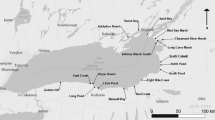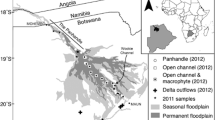Abstract
Remote high elevation sites are thought to be good sites to monitor global change and anthropogenic effects on ecosystems. This study was conducted during 1987–1990 in a high elevation wetland (3593 m) located in the Green Lakes Valley, Front Range, Colorado (USA). Salix spp. was the dominant riparian species in this 2 ha. wetland. Small shallow pools (<0.5 m depth) constituted a water area of 236 m3. The major source of water during the study period was snowmelt. The wetland had a well defined outlet and inlet, although an undetermined amount of water entered as groundwater from the snow patch above. Outlet discharge was 424–460 m3 during the month of July and declined thereafter as water input from the snowpatch declined. Inlet discharge was 67% of outlet discharge. Water temperatures in the outlet were always less than 6.8°C, pH 6.0–6.3, and mean conductivity 30.8 µS cm−1. Both NO sup−inf3 and SO sup−2inf4 were higher in the inlet thanin the outlet. Dominant cations in the inlet and outlet waters were Ca+2 ≫ Mg+2 > K+ + Na+; dominant anions were SO sup−2inf4 ≫ HCO sup−inf3 > NO sup−inf3 ≫ Cl−. Nutrient limitation by P was demonstrated once using nutrient diffusing substrata. No limitation could be shown for NO sup−inf3 , HCO sup−inf3 , or Fe+EDTA. Slow colonization rates of periphyton on tiles were attributed to low temperatures and/or ultraviolet radiation. However, interannual differences in biomass on tiles were as much as 300% after 35 days. A minimum of 16–54 samples would be needed to detect a significant interannual change in biomass on tiles after 35 days assuming that the extreme case for periphyton patchiness. Global climate change is likely to affect discharge and water temperature in this wetland which hill have direct and indirect affects on population dynamics and ecosystem function.
Similar content being viewed by others
References
Albertson, M. & D. Simons, 1964. Fluid mechanics. Section 7. In V. T. Chow (ed.), Handbook of Applied Hydrology. McGraw Hill, New York, USA, 1012 pp.
Aloi, J., 1990. A critical review of recent freshwater periphyton field methods. Can. J. Fish. aquat. Sci. 47: 656–670.
American Public Health Association, 1985. Standard methods for the examination of water and wastewater, 16th edn. APHA. Washington, D.C., USA, 769 pp.
Bachmann, R., W. Crumpton & G. Hallberg, 1991. Nitrogen losses in an agricultural stream. Verh. int. Ver. Limnol. 24: 1641–1643.
Baron, J. & O. Bricker, 1987. Hydrologic and chemical flux in the Loch Vale Watershed, Rocky Mountain National Park. In R. Averett & D. McKnight (eds), Chemical quality of water and the hydrologic cycle. Lewis Publishing Co., Chelsea, Michigan, USA: 141–157.
Barnes, H. H. Jr., 1967. Roughness characteristics of natural channgels. Geological Survey Water Supply Paper 1848. U.S. Geological Survey. Superintendent of Documents, Washington, D. C. USA, 213 pp.
Barry, R., 1973. A climatological transect on the east slope of the Front Range, Colorado. Arct. Alp. Res. 5: 89–110.
Barry, R., 1981. Mountain weather and climate. Methuen Publishing Co., New York, USA, 313 pp.
Bothwell, M., 1985. Phosphorus limitation of periphyton growth rates. An intersite comparison using continuous flow troughs (Thompson River System British Columbia). Limnol. Oceanogr. 30: 527–542.
Bothwell, M., 1989. Phosphorus-limited growth dynamics of lotic periphytic diatom communities: areal biomass and cellular growth rate responses. Can. J. Fish. aquat. Sci. 46: 1293–1301.
Bothwell, M., D. Sherbot, A. Roberge, R. Daley, 1993. Influence of natural ultraviolet radiation on lotic periphytic diatom community growth, biomass accrual, and species composition: Short term vs long term effects. J. Phycol. 29: 24–39.
Bruns, D., Wiersma, G. & G. Minshall, 1991. Problems of long-term monitoring of lotic ecosystems. In Penelope Firth & Stuart G. Fisher (eds), Global Climate Change and Freshwater Ecosystems. Springer-Verlag, New York, USA: 285–307.
Burns, S. F., 1980. Alpine soil distribution and development, Indian Peaks, Colorado Front Range. Ph.D. dissertation. University of Colorado, Boulder, Colorado, USA, 360 pp.
Caine, N., 1990. Personal Communication. Institute of Arctic and Alpine Research, University of Colorado, Boulder, Colorado, USA.
Caine, N. & E. Thurman, 1990. Temporal and spatial variations in the solute content of an alpine stream. Geomorphology 4: 55–72.
Caine, N., 1989. Diurnal variations in the inorganic solute content of water draining from an alpine snowpatch. Catena 16: 153–162.
Callahan, J. T., 1984. Long-term ecological research. Bioscience 34: 363–367.
Cole, J. & S. Fisher, 1979. Nutrient budgets of a temporary pond ecosystem. Hydrobiologica 63: 213–222.
Denning, S., J. Baron, M. Mast & M. Arthur, 1991. Hydrologic pathways and chemical composition of runoff during snowmelt in Lock Vale watershed. Rocky Mountain National Park, Colorado, USA. Wat., Air Soil Pollut. 59: 107–124.
Driscoll, C. & R. Newton, 1985. Chemical characteristics of Adirondack lakes. Envir. Sci. Tech. 19: 1018–1024.
Fairchild, G., R. Lowe & W. Richardson, 1985. Algal periphyton growth on nutrient diffusing substrates. Ecology 66: 465–472.
Fairchild, G. W. & A. C. Everett, 1988. Effects of nutrient (N, P, C) enrichment upon periphyton standing crop, species composition and primary production in an oligotrophic softwater lake. Freshwat. Biol. 19: 57–70.
Halterman, S. & D. Toetz, 1984. Kinetics of nitrate uptake by freshwater algae. Hydrobiol. 114: 209–214.
Hicks, D. M. & P. D. Mason, 1991. Roughness characteristics of New Zealand rivers. Water Resources Survey, Kilbimie, Wellington, New Zealand, 329 pp.
Horner, R. R. & E. B. Welch, 1981. Stream periphyton development in relation to current velocity and nutrients. Can. J. Fish. aquat. Sci. 38: 449–457.
Horner, R. R., E. B. Welch & R. B. Veenstra, 1983. Development of nuisance periphytic algae in laboratory streams in relation to enrichment and velocity. In: R. G. Wetzel (ed.), Periphyton of Freshwater Ecosystems. Dr W. Junk Publishers, The Hague, The Netherlands: 121–131.
Jarrett, R. D., 1984. Hydraulics of high gradient streams. J. Hydraulic Engineering. ASCE 10: 1519–1539.
Johannessen, M. & A. Hendriksen, 1978. Chemistry of snow meltwater; changes in concentration during melting. Wat. Res. Res. 14: 615–619.
Kling, G. W. & M. C. Grant, 1984. Acid precipitation in the Colorado Front Range: An overview with time predictions for significant effects. Arct. Alp. Res. 16: 321–326.
Kratz, T., T. Frost & J. Magnuson, 1987. Inferences from spatial and temporal variability in ecosystems: Long-term zooplankton data from lakes. Am. Nat. 129: 830–846.
Krebs, C. J., 1989. Ecological methodology. Harper and Row, New York, USA, 654 pp.
LaPerriere, J., E. Van Nieuwenhuyse & P. Anderson, 1989. Benthic algal biomass and production in high subarctic streams, Alaska. Hydrobiologica 172: 63–75.
Linsley, R. K., Kohler, M. A. & J. Paulhus, 1975. Discharge/stage relationships. Hydrology for Engineers. 2nd edn. McGraw Hill Inc., New York, USA: 119–131.
Litaor, I. M., 1988. Soil solution chemistry in an alpine watershed. Arct. & Alp. Res. 20: 485–491.
Litaor, M. & E. Thurman, 1988. Acid neutralizing processes in an alpine watershed Front Range, Colorado, USA—1: buffering capacity of dissolved organic carbon in soil solutions. Appl. Goechem. 3: 645–652.
Losleben, M., 1990. Personal Communication, Institute of Arctic and Alpine Research, University of Colorado, Boulder, Colorado, USA.
Magnuson, J. J. & C. J. Bowser, 1990. A network for long-term ecological research in the United States. Freshwat. Biol. 23: 137–143.
Martin, J., R. Gordon & S. Fitzwater, 1991. The case for iron. Limnol. Oceanogr. 36: 1793–1802.
McKnight, D., C. Miller, R. Smith, J. Baron & S. Spaulding, 1988. Phytoplankton populations in Loch Vale, Rocky Mountain National Park, Colorado: Sensitivity to acidic conditions and nitrate enrichment. U.S. Geological Survey, Denver, Colorado, USA. Water Resources Investigations Report 88-4115, 102 pp.
McKnight, D. N., R. L. Smith, J. P. Bradbury, J. S. Baron & S. Spaulding, 1990. Phytoplankton dynamics in three Rocky Mountain Lakes, Colorado, USA. Arct. & Alp. Res. 22: 264–274.
Mihuc, T. & D. Toetz, 1993. Determination of diets of alpine aquatic insects using stable isotopes and gut analyses. Am. Midl. Nat. 131: 146–155.
Osburn, W., 1967. Ecological concentration of nuclear fallout in a Colorado watershed. In B. Alberg & F. P. Hungate (eds), Radioecological Concentration Processes. Pergamon Press, New York, USA: 675–709.
Perrin, C. J., M. L. Bothwell & P. A. Slaney, 1987. Experimental enrichment of a coastal stream in British Columbia: Effects of organic and inorganic additions on autotrophic periphyton production. Can. J. Fish. aquat. Sci. 44: 1247–1256.
Peterson, B. J., J. E. Hobbie, A. E. Hershey, M. A. Lock, T. E. Ford, J. R. Verstal, V. L. McKinley, M. A. J. Hullar, M. C. Miller, R. M. Ventullo & G. S. Volk, 1985. Transformation of a tundra river from heterotrophy to autotrophy by addition of phosphorus. Science (Wash., DC) 229: 1383–1386.
Rhee, G. Y. & I. J. Gotham, 1980. Optimum N: P ratios and coexistence of planktonic algae, J. Phycol. 16: 486–489.
Rudd, J., C. Kelly, V. St. Louis, R. Heslein, A. Furutani & M. Holoka, 1986. Microbial consumption of nitric and sulfuric acids in acidified north temperate lakes. Limnol. Oceanogr. 31: 1267–1280.
SAS Institute, Inc., 1985. SAS/STAT Guide for Personal Computers Version, 6th edn., Cary, N.C., 584 pp.
Schindler, D., G. Brunskill, S. Emerson, W. Broecker & T. H. Peng, 1972. Atmospheric carbon dioxide; its role in maintaining phytoplankton standing crops. Science 177: 1192–1194.
Skougstad, M., N. Fishman, L. Friedman, D. Erdmann & S. Duncan, 1979. Methods for determination of inorganic substances in water and fluvial sediments. Techniques of Water-Resources Investigations of the United States Geological Survey, Denver, CO, USA, Open file rep., 78–679, 1006 pp.
Solorzano, L., 1969. Determination of ammonia in natural waters by the phenolhypochlorite method. Limnol. Oceanogr. 14: 799–801.
Stauffer, R., 1990. Granite weathering and sensitivity of alpine lakes to acid deposition. Limnol. Oceanogr. 35: 1112–1134.
Strickland, J. & T. Parsons, 1972. A practical handbook of seawater analysis. J. Fish. Res. Bd. Can. Bull. 167, 310 pp.
Tate, C., 1990. Patterns and control of nitrogen in tall-grass prairie streams. Ecology 71: 2007–2018.
Toetz, D. & J. Windell, 1993. Phytoplankton in high elevation lakes, Colorado Front Range: Application to lake acidification. Great Basin Nat. 53: 350–357.
U.S. Environmental Protection Agency, 1979. Methods for chemical analysis of water and wastes. 4–79–020, U. S. EPA, Cincinnati, OH, USA.
Wahl, K., 1994. Bias in regression estimates of Manning's n. J. Hydraulic Engineering, ASCE 117: 727–732.
Wetzel, R. & G. Likens, 1979. Limnological Analyses. Saunders, Philadelphia, PA, USA, 293 pp.
Author information
Authors and Affiliations
Rights and permissions
About this article
Cite this article
Toetz, D. Water chemistry and periphyton in an alpine wetland. Hydrobiologia 312, 93–105 (1995). https://doi.org/10.1007/BF00020765
Received:
Revised:
Accepted:
Issue Date:
DOI: https://doi.org/10.1007/BF00020765




